“The historian’s special contribution is the discovery of the manifold shapes of time. The aim of the historian, regardless of his specialty in erudition, is to portray time. He is committed to the detection and description of the shape of time.” George Kubler, The Shape of Time, 1962.
“And when he has conquered all the depths of space, and all the mysteries of time, still he will be beginning … “H. G. Wells, The Shape of Things to Come, 1933.
Science fiction never doubted that the wristwatch had a future. Even if the future was far more technologically advanced, with intergalactic space travel or killer androids, a watch was still a necessity. Such a belief was rational as even into the 1970s, when the quartz era was firmly under way, astronauts were still issued with a mechanical Omega Speedmaster. There was a trust in the known analogue technology despite the availability of arguably superior timekeeping movements, of which Bulova’s electronic “Tuning Fork” and the Beta 21 (Omega Marine Chronometer) come to mind.
Galaxy Science Fiction magazine, October 1951, with cover illustration by Richard Arbib.
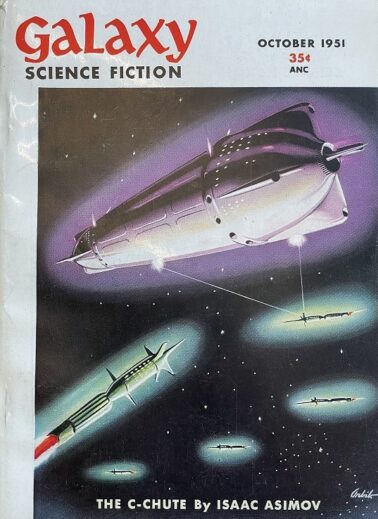
There is no constant to time. The question of what the watch of the future would look like now, given that “now” and the “future” are constantly changing terms, equally evolves over time. What laid ahead in 1950 looked very different to what does today, and the influence of science fiction on design has metamorphosed accordingly.
Horology’s first foray into the science fiction world of tomorrow was with industrial designer Richard Arbib. The 1950s were a brave new Earth for what the celestial future could be. Magazines were dedicated to the subject of what space exploration would hold; spaceship captains that starred in their own comics were as numerous as regular airline pilots. Given the collective amount of cosmic villainy being perpetrated beyond Earth, it was surprising there was any form of civilisation – let alone watchmakers – left on it at all.
Richard Arbib could claim credits both as a science fiction artist and as a designer. A regular cover illustrator for Galaxy Science Fiction magazine, he was also commissioned by the American Motors Corporation (AMC) to create a unique futuristic car for the Hudson Motor Car Company. Arbib called the main design theme “V-line” styling where the “V” form was used throughout the vehicle. More importantly, he designed the concept Astra-Gnome “Time and Space Car” which featured a celestial time-zone clock permitting actual flight-type navigation.
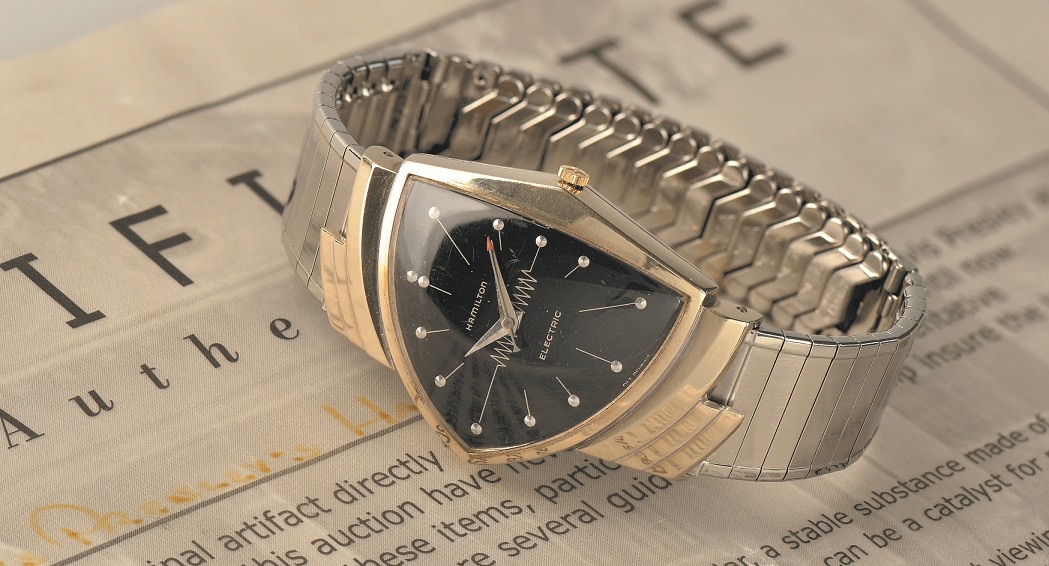
Hamilton Ventura previously owned by Elvis Presley, circa 1958.
In the mid-1950s the US watch manufacturer Hamilton hired Arbib to design futuristic watches for their new battery powered electric movement. The Ventura had an asymmetric “V” design that became iconic from the very start. Elvis famously swapped his diamond studded Omega for one. The watch looks as futuristic today as it did in 1957 when it first went on sale. Still in production, the Ventura was used as standard issue for the agents in the comedic science fiction movie Men in Black.
Hamilton was not alone in hiring outside designers to produce a new futuristic look to their watches. Even the paragon of Swiss watchmaking, Patek Philippe, hired a young Gilbert Albert in the same decade to produce modern timepieces in keeping with the age. With names like “Flying Saucer”, “Asymétrie”, and “Futuriste”, the watches were similar in form to the new aesthetics being produced by Arbib in the U.S. Although it is not known if Albert was influenced by science fiction, in 1958 Patek released the ref. 3412, which was remarkably similar to the Hamilton Ventura.
The beginning of the 20th century had been the last time watch case design had changed, thanks to the Art Deco movement and revolutionaries like Louis Cartier and the underground design “dilettantes” at the ateliers of Patek Philippe and Vacheron Constantin. It was a peaceful coup that won the hearts and minds of a new consumer. A similar trend took place in the science orientated society of the 1950s. The dictatorship of the norm, where watches were round, rectangular or tonneau, was being shifted. A “V” was always an indication of time’s arrow into the future, and Arbib and Albert had shown the way forward to the horological world.
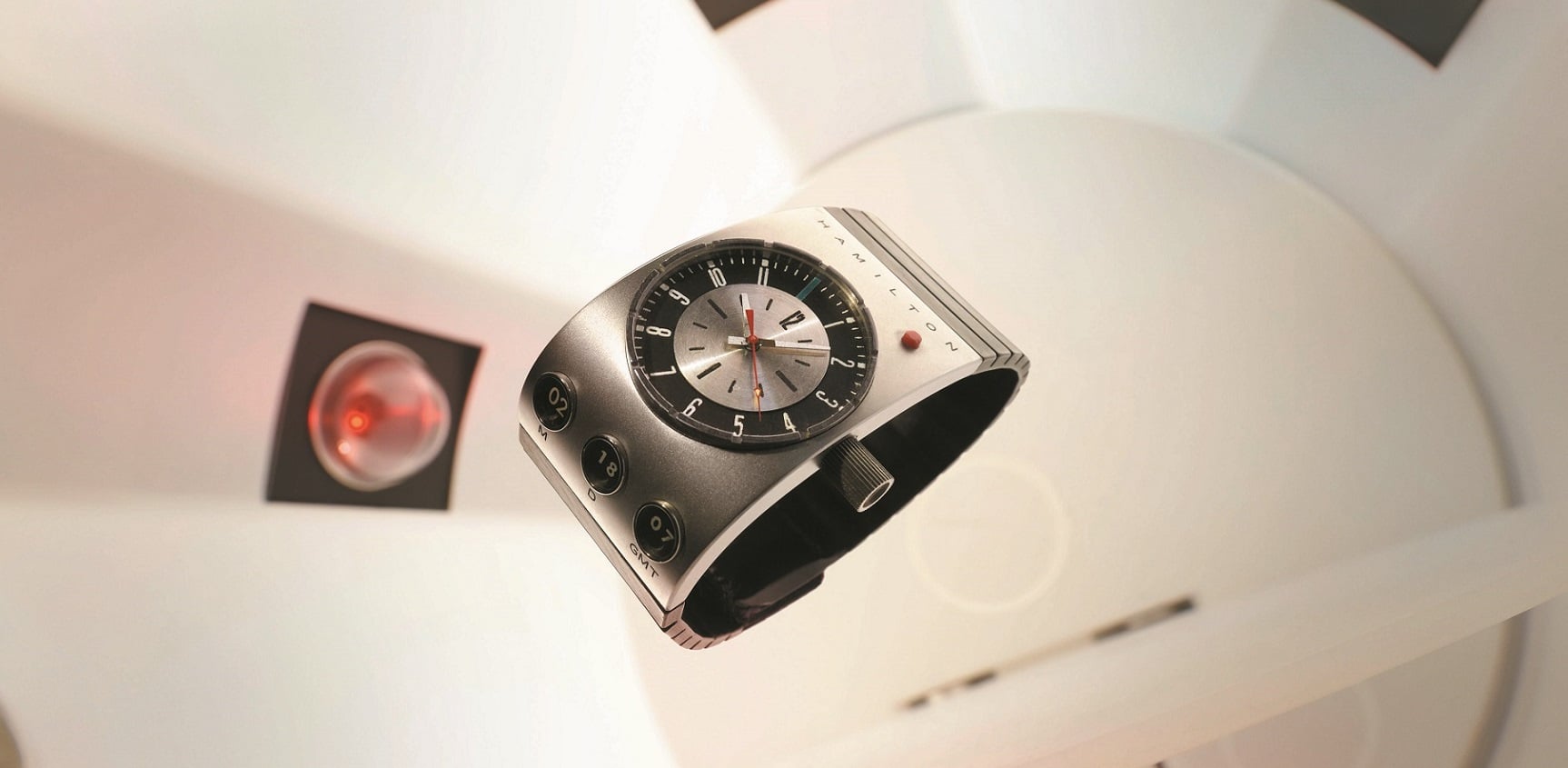
Hamilton Odyssey 2001, with an analogue display for the time and a digital readout for all other functions.
Hamilton returned to the avant-garde of science fiction when they were asked by Stanley Kubrick to develop a watch for 2001: A Space Odyssey. The result was a complex combination of a curved rectangular case with an analogue display for the time and a digital readout for all other factors. The functions went as far as what would now be called a smartwatch. However, what appeared in the film was too expensive to put into production, so Hamilton issued the “Odyssee 2001” based on the analogue part of the watch depicted in the movie. The design was still futuristic with its unusual wedge-shaped case and dial layout.
By the latter part of the 20th century, the science fiction watch was no longer an imaginative shape for a possible future, but rather a realised object that had to be part of tomorrow’s aesthetic as an addition to the wrist of elite troops dealing battling xenomorphic aliens on distant planets or killer android robots that had to stop the countdown on earth exterminating event.

Giorgetto Giugiaro designed the above Seiko for the 1986 blockbuster, Aliens. The watch was worn by main character Ripley.
Aliens, released in 1986, takes place in the year 2179, when humans have encountered rather aggressive extra-terrestrial lifeforms. The future watch in this instance was Giorgetto Giugiaro’s designed Seiko worn by Ripley (Sigourney Weaver) and Bishop (Lance Henriksen). Giugiaro is more famous for his angular style of car design and was not influenced by what the science fiction future should look like. In keeping with his style, the two watches in question were reference 7A28-6000 and 7A28-7000, the latter being worn by Ripley. Made of aluminium and steel, ref. 7A28-7000 boasted an asymmetric offset case and a futuristic bracelet. The pushers to operate the chronograph function were contained in a rectangular protrusion on the right side.
In Terminator: The Rise of the Machines (released in 2003), Arnold Schwarzenegger helped design an oversized Audemars Piguet Royal Oak Offshore that was discovered by the cyborg in the sun visor of a truck. Understandably, the killer robot has little use for a mechanical watch and sets it aside. With a diameter of 51mm, the three-part Royal Oak case had two chronograph pushers in the band with lock levers and a protected crown, so the countdown wouldn’t be interrupted once started.
Audemars Piguet Royal Oak Offshore T3 designed for the movie Terminator 3 The Rise of the Machines
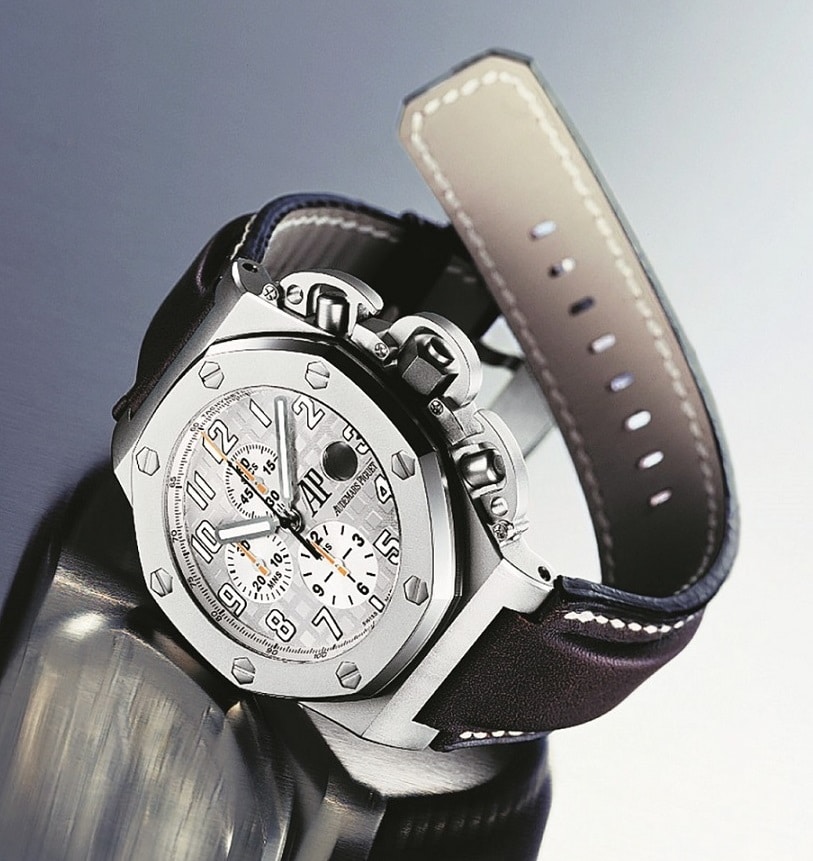
In the same way that the outline of the WWI Renault tank was Louis Cartier’s muse in reshaping the gentleman’s wristwatch, the imagined machines of a galaxy far far away provide ideas for contemporary designs. Both Martin Frei of Urwerk and Max Busser at MB&F acknowledge the influence that fictional spaceships have on their creativity.
You cannot help but look at the new Urwerk UR-100 from above and see the outline of Star Wars Millennium Falcon. For Martin Frei, who grew up with genre-changing science fiction movies like Star Wars, Alien, and Bladerunner, the films are a time machine that allows a view of the past and the future in the present moment. He went further and explained that “All Urwerk watches are inspired by science fiction. A science fiction film that looks into the future is related to time. But it is also the idea to imagine technology that interests me. If you create contemporary avant-garde watches, they will look as if they were from a history of the future. You have to look for new shapes and new concepts.”
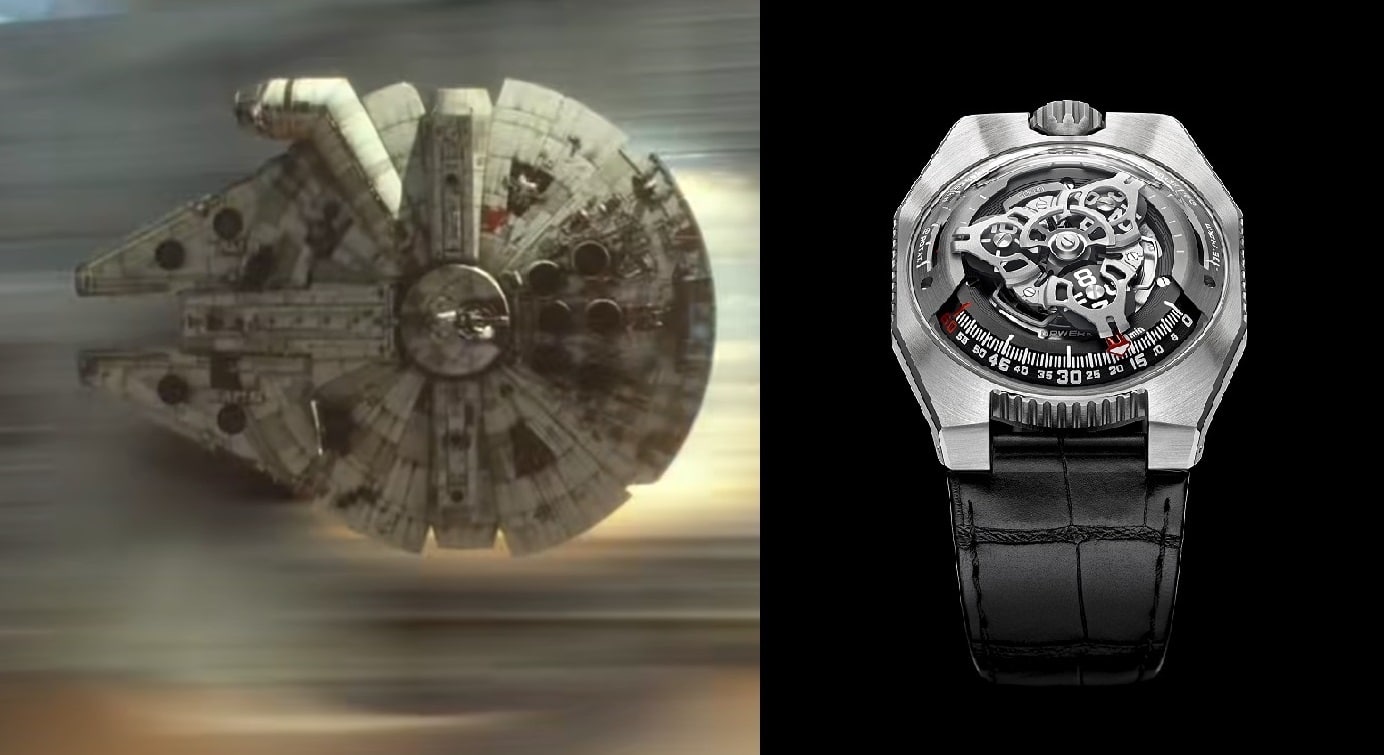
If you look at the new Urwerk UR-100 from above it is difficult not to see the outline of Star Wars Millennium Falcon.
In designing Horological Machine No 6 (HM6), aka “Space Pirate”, Max Busser referenced the spaceship design from the anime version of Captain Future. Max acknowledges the effect the past has on his creative present. Also a veteran of the late 20th century cinematic big bang in science fiction, the memories from an impressionable childhood have left an indelible mark on his horological machines. HM6 started with “a certain amount of sketching and a large amount of imagination. It was the two spaceships with their two spheres connected by a central link that inspired our design with the tourbillon at the centre.”

On the left, MB&F HM6 in steel showing the dual Captain Future spaceship configuration (right).
Another futuristic watch is the DeBethune Dream Watch 5. While some people have noted the similarity of the design to some fictional spaceship forms, Denis Flageollet was quick to point out that he hadn’t been inspired by a particular movie or comic, but rather by the possibilities of time travel, which he refers to as “cosmic inspiration.”
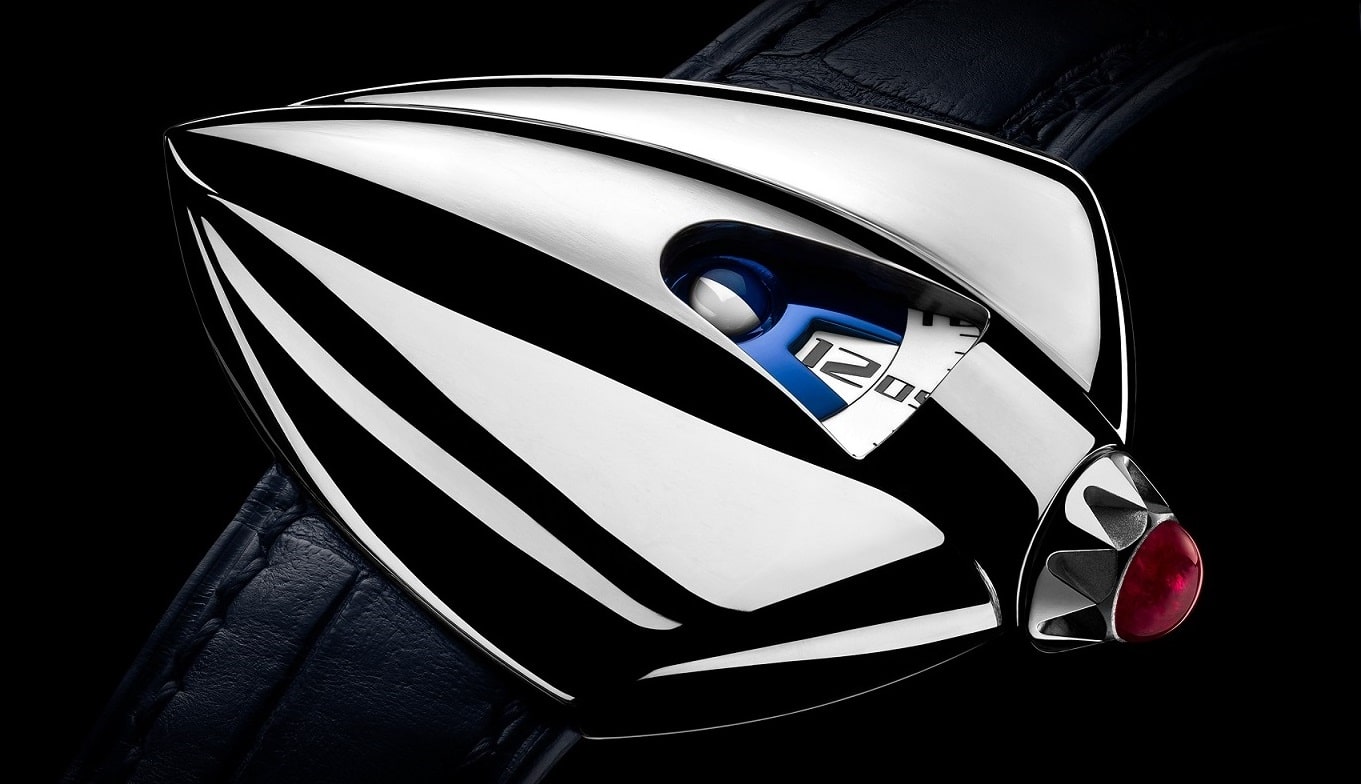
DeBethune Dream Watch 5 with its futuristic styling.
The relationship between science fiction and watch design has changed. No one now believes that a mechanical watch will accompany Captain Dan Dare in his journeys to the stars and beyond. We realise that it will be a wrist-bound subservient satellite of some other device and will relay all manner of information, as well as the time. However, the allure of designing watches for space travel has lost none of its lustre. It is still a flight of fancy into the unknown. Konstantin Chaykin designed and produced the Mars Conqueror, which embodies the realisation that time will be different on a new planet and that there will be a new measure of the “day” (however defined) and the units of time within it. Mars measures time in SOLs that are approximately 40 minutes longer than an Earth day. The past of space exploration is embedded in the Mars Conqueror, with design ques from the Vostok rockets that once carried the hopes of the socialist space future into the stars. While we can dream, we can let our imagination run wild and enrichen the world of horological creativity.
My thanks to Martin Frei, Max Busser and Denis Flageollet for their help and advice in researching this article.
Opening picture: Stylised concept art for the Richard Arbib Astra-Gnome car, circa 1956.














Show Comments +